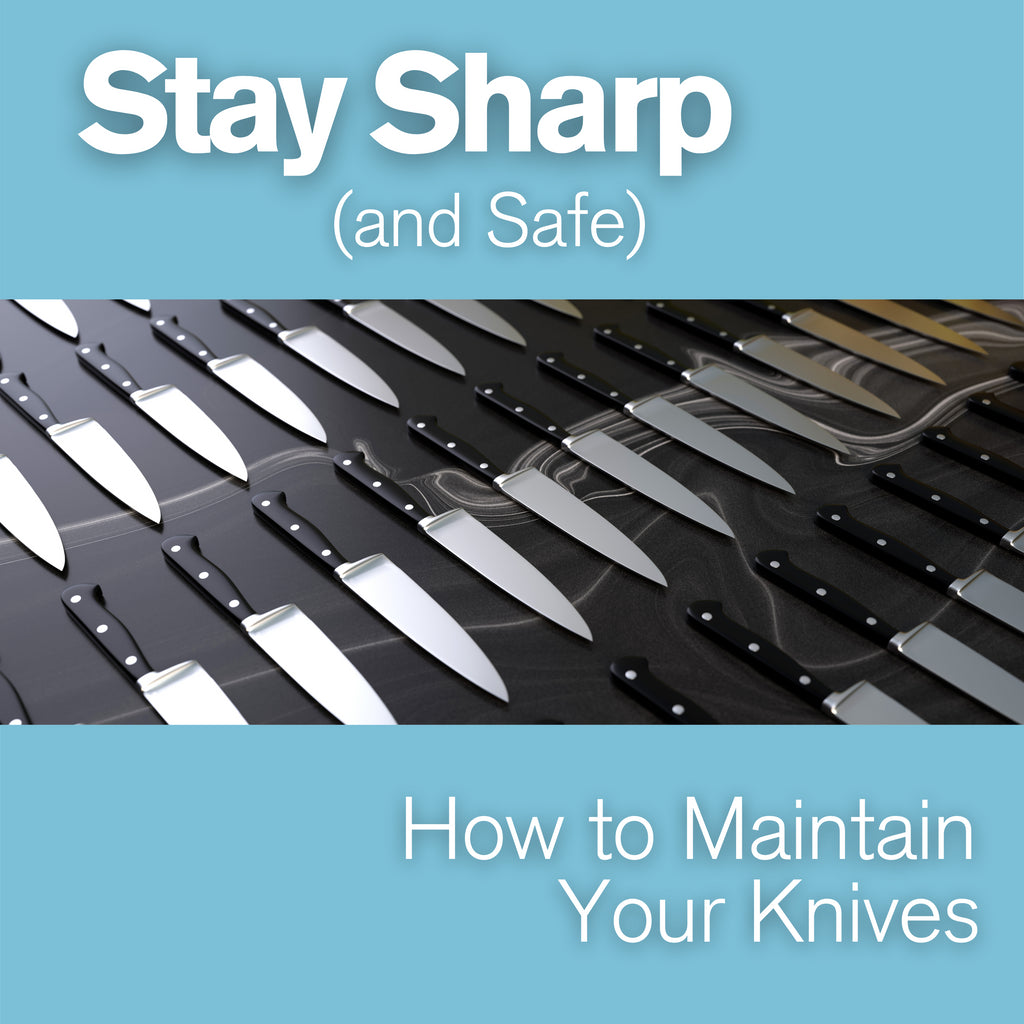How To Maintain Your Professional Knives
Posted by CHERIE THOMPSON

Keep your professional knives sharp and safe with proper maintenance and storage
Maintaining your chef and kitchen knives takes a little time and effort, but it will pay dividends in the long run. If you keep them sharp, clean and protected from damage. A good set of kitchen knives will last a lifetime. You paid a lot of money for those knives, so protect your investment!
A sharp knife edge makes cutting and slicing easier and more accurate. Sharp knives are also safer: you need to apply more pressure with a dull blade, which will tend to slip and so increase the chance of injury.
Honing and Sharpening
Honing
Honing and sharpening are not the same thing. Honing is what you should do every time you start a task – running the knife edge over a honing (or sharpening) steel a few times. Doing this maintains an edge that’s already sharp. All you are doing is realigning the edge of the blade, not filing away the metal.
It’s an easy technique once you’ve got the hang of it. Hold the steel vertically in one hand and, with your knife in the other hand, slide the blade down and across the steel at a 15-degree angle. Repeat this a few times, alternating sides.
Your honing steel – not including the handle - should be a bit longer than your longest knife.

Sharpening
Over time even the best maintained knives lose their edge, become dull, and have to be sharpened. Sharpening means removing a small amount of material from the knife’s edge. This can be done professionally by a sharpening service, knife sharpeners or a sharpening stone.
Conventional whet stones have a coarse surface on one side and a fine surface on the other. The technique for using a sharpening stone rather depends on the type of stone you have; just follow the manufacturer’s instructions.

Storage
Let’s get this out of way immediately: DO NOT keep your knives loose in a kitchen drawer! This is dangerous both for your knives and your fingers. Proper knife storage is the best protection - with so many options, you will find the best one for your needs.
Knife Blocks
A knife blocks are popular and it’s easy to see why: they look attractive and your knives are easily accessible.
But knife blocks take up valuable counter space, there may not be spaces for all your knives and they can dull knife blades through contact with the wood. Also, you can’t easily identify which knife is which until you take one out. Or that used to be the case.
There are more options available these days to offer busy kitchens safe and convenient ways to store knives. Some knife storage stations have see-through closed boxes that keep out the contaminants, reduce damage but still display the knife blades to quickly retrieve the one you want. And dishwasher safe.
Magnetic Knife Strips
A wall-mounted magnetic knife strip solves all these problems at a stroke, and it’s probably cheaper. Just fix it to your kitchen wall in a handy location. These don’t work, however, with ceramic knives.
If you really have no option but to store your knives in a drawer, then knife guards are the way to go.
Knife Rolls
If you have to carry your knives from place to place there are knife bags (also called knife rolls) on the market for as many or few knives as you need to transport.
A knife roll is a great option for safely storing your precious knives. Ranging from 7 to 12 pockets, available in multiple colours and various fabrics, you are certain to find one that suits your style.

Cleaning
Another piece of essential advice: whenever possible, don't put your knives in the dishwasher! Even if your knives are “dishwasher safe” the jostling action of the machine will dull the blades over time.
Clean your knives each time after use. Hand-wash with warm soapy water, rinse, then sanitize.
Carbon steel knives are notoriously high maintenance. They rust easily and have to be wiped frequently, especially if exposed to anything acidic. Some discolouration is inevitable and acceptable. Rub them down with mineral oil regularly.
Proper usage of knives
If you’ve learnt good knife skills you already know most of what there is to know about the proper usage of knives. A good cutting technique uses as little pressure as possible; the weight of the knife should do most of the work. Understanding your knives ensures that you’ll use the right knife for the right job – no hacking at bones with your chef’s knife, please!
Cutting Boards: Wooden cutting boards are the kindest to knife edges. Plastic boards are less kind, but not disastrously so. Always use a cutting board. Check out the many sizes and styles we have available in our Cutting Board Collection.
Please, don’t use your countertop to cut items on. This will do neither your knife – nor your countertop - any favours.
Written by Charles Bruce-Thompson
Looking for Professional Knives? Check out our Chef and Kitchen Knives Buying Guide.
FAQ
Are magnetic knife strips a good option for knife storage?
Magnetic knife strips can be a convenient and space-saving option for knife storage, as they securely hold knives on a wall or other surfaces. However, it's important to ensure the strip is strong enough to hold the weight of the knives, and some people may prefer other storage options to protect the blades from potential scratching or damage.
What are the advantages and disadvantages of using a knife block for storage?
Knife blocks provide a safe and organized way to store knives on the countertop, keeping them easily accessible. However, they can take up counter space and may not accommodate knives with longer or wider blades. Additionally, if not properly cleaned and dried, knife blocks can accumulate dirt and moisture, potentially affecting knife hygiene.
Why would I use knife storage rather than just put knives in drawers?
Using dedicated knife storage options, such as blocks, magnetic strips, or knife rolls, helps protect the knives' blades from damage or dulling that can occur when stored loosely in drawers. It also reduces the risk of accidents when reaching into a drawer and provides better organization, making it easier to locate the desired knife quickly.
How should I store knives with serrated edges to maintain their sharpness?
To store knives with serrated edges, it is best to use a knife block or a knife roll with individual slots/pockets that can securely hold each knife separately. This prevents the knives from rubbing against each other, reducing the risk of damaging the serrated edges. Alternatively, blade guards or sheaths designed for serrated knives can be used to protect the edges.
What are the benefits of using a knife roll or knife bag for storage?
The benefits of using a knife roll or knife bag for storage include portability, protection, and organization. They allow for easy transport of knives, provide individual compartments or pockets to prevent blades from rubbing against each other, and often have additional storage space for other kitchen tools or accessories.
How can I organize and store a large collection of knives effectively?
Organizing and storing a large collection of knives can be done effectively by using a knife block or magnetic strip for frequently used knives, and a knife roll or knife bag for storing the rest. Separating and categorizing the knives based on their type and frequency of use can help in efficient organization and access.
Are there any specific recommendations for storing specialty knives, such as Japanese or ceramic knives?
Specialty knives, such as Japanese or ceramic knives, require extra care in storage. It is recommended to store Japanese knives in a knife block, magnetic strip, or knife roll designed specifically for their shape and size to protect the delicate blades. Ceramic knives should be stored in a knife block or knife roll with individual slots to prevent contact with other knives and avoid chipping or breaking the ceramic blades.

TAGS:

